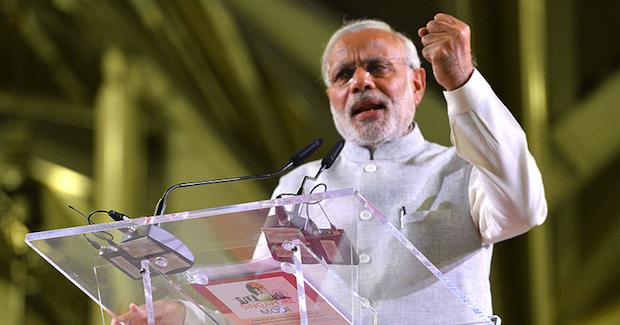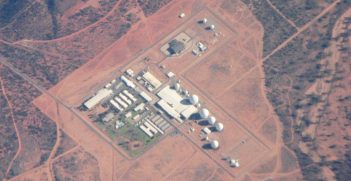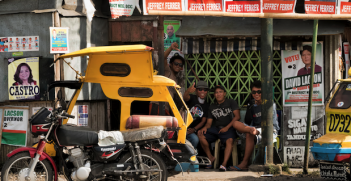India's Republic Day: Modi at Midterm

On this day in 1950, the Indian constitution came into effect creating the world’s largest democracy. In 2017 there will be legislative elections in five of the mega-democracy’s most populous states and Narendra Modi’s enigmatic leadership will be under the spotlight. A good result for Modi’s Bharatiya Janata Party is critical.
In September 2014, the newly elected Indian Prime Minister Narendra Modi addressed a sold-out crowd of 20,000 ardent fans at Madison Square Garden in New York City. This was more than a political speech, it was a Bollywood-worthy spectacular complete with Gujarati folk dancing, Rajasthani pop music, Hindi devotionals, motivational narration, strobe lighting and a rotating stage.
The Wall Street Journal live-blogged the event, gushing “What will he wear?” and subjecting readers to a deconstruction of Modi’s many coloured short-sleeved kurtas. Modi had swept to power the preceding March with promises of policy reform, development, dignity and his slogan achhe din aane waale hain (good days are coming). Voters fed up with corruption scandals and soaring inflation handed him the most significant electoral mandate of any Indian prime minister since Rajiv Gandhi won the 1984 general election following the assassination of his mother, Indira.
Modi’s success as a reformist prime minister has, however, been muted. His Bharatiya Janata Party (BJP) battled through a damp squib of a year in 2015 and entered 2016 after losing power in Delhi and Bihar. While 2016 was an improvement, with the BJP gaining ground on the economy as well as prioritising agricultural and infrastructure spending, it will be 2017 that will decide whether Modi is on track to win India’s 2019 general election. Though still personally extremely popular—research conducted by PEW last year indicated that a strong majority (81 per cent) of Indians still consider Modi in favourable terms—reactions to his policies are beginning to split along partisan lines.
Demonetisation has helped revitalise Modi’s faltering reform narrative to some degree, but the sheer inconvenience and violence caused by the experiment risks losing the BJP votes in the upcoming 2017 state legislative assembly elections. Modi tirelessly invoked nationalist tropes while (mainly poor) Indians stood for hours in serpentine bank queues. In terms of policy direction, demonetisation left many confused about Modi’s approach to India’s complex economic environment. Writing in The Telegraph, Swapan Dasgupta, an historically liberal interpreter of BJP policies, argued that Modi may be on the verge of executing a “dramatic socio-political realignment” after his demonetisation move, though Dasgupta goes on to stress that Modi’s project is modernist and certainly does not resemble the socialism of the Congress Party during the 1960s and 1970s. Meanwhile, Rakesh Sinha, an academic from Delhi University, went so far as to argue in The Indian Express that demonetisation was aimed at reviving the socialist egalitarianism of Mahatma Gandhi, and countering Western neoliberal economic policies.
If demonetisation is in fact just the first of many state-led socialist policies, does this threaten the investment-friendly—both domestic and foreign—promises that underscored Modi’s 2014 election campaign? Modi manages to possess a somewhat enigmatic quality: he is different things to different people. This might be politically expedient but it’s also rather confusing.
In February and March this year, one fifth of the entire Indian electorate—690 constituencies—will vote when the five states of Uttar Pradesh, Goa, Punjab, Uttarakhand and Manipur go to the polls. These 2017 legislative assembly elections will confirm whether or not the Indian people still believe in the enigma of Modi and whether his achhe din promise still holds any weight.
The one to watch will be Uttar Pradesh; India’s most populous state has not been held by the BJP for 15 years. The party has long been sidelined by political duelling between the Samajwadi Party and Bahujan Samaj Party (BSP), and the two stalwarts continue to present a formidable challenge. The BSP’s inimitable figurehead, Mayawati, is working steadily to win back the young, educated Dalit vote she feared had drifted over to the BJP in the 2014 general election. Mayawati is also counting on a significant Muslim turnout as a result of the Samajwadi Party’s internecine fighting and the fact that a majority of Muslim voters in the state usually aim to vote strategically against the BJP and its Hindu nationalist ideology. Meanwhile, the only other real contender, the Congress Party, has barely campaigned at all in Uttar Pradesh. Campaign spearhead Rahul Gandhi is on holiday abroad and has only been occasionally politically active on Twitter.
At stake in the battle for Uttar Pradesh is the BJP’s power in the Rajya Sabha (India’s upper house), which it desperately needs to increase if the party hopes to have a chance of passing any meaningful legislation prior to the 2019 general election. Some analysts have posited that the timing of demonetisation is linked to the upcoming Uttar Pradesh election—both the Samajwadi Party and BSP are known to campaign with large amounts of cash. Uttar Pradesh—and the other assembly elections this year—are also important if the BJP wants to fill the coveted post of president of India, which comes up for renewal in July 2017 when Pranab Mukherjee completes his five-year term. Members of the Legislative Assembly in Uttar Pradesh, who will participate in the presidential election, control a significant portion (83,824) of the more than one million votes that are considered in electing the president of India.
Exactly what type of president the BJP are able to put forward will also depend on their success in Uttar Pradesh and the other upcoming assembly elections. Pranab Mukherjee is a firm Congressman while his predecessor, APJ Abdul Kalam, was a non-partisan moderate and a compromise candidate—even though he was appointed under the previous BJP-led Coalition Government. The 2017 presidential election represents the first time the BJP has had the opportunity to put forward a proper ‘saffron’, right-wing politician for the highest office in the county.
In a victory speech on 16 May 2014, Modi proclaimed that the BJP would “change the face of India in ten years”. For a man who had just been elected for a five-year term, in a party who had only previously governed in coalition for one full term, a decade ago, this seemed optimistic. Just two years out from the 2019 general elections, however, Modi’s words are looking increasingly prophetic. Helped along by Rahul Gandhi’s enduring reluctance to fully participate in the Indian political landscape (which does the Congress Party no favours) and the apparently effective demonetisation experiment, only the 2017 state legislative assembly elections stand in his way.
As long as Modi can keep voters focused on his own persona rather than on more partisan policy issues, he should be able to (at the very least) maintain current levels of support. Perhaps Modi’s acche din have finally arrived.
Dr Kimberley Layton holds a PhD in International Studies from the University of New South Wales, where her research focused on Hindu nationalism in the Indian Diaspora. She is also a former AIIA Euan Crone Asian Awareness Scholarship Holder and National Office intern.
This article is published under a Creative Commons Licence and may be republished with attribution.





